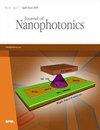在微通道中制作用于表面增强拉曼光谱的银装饰氧化锌纳米线传感器
IF 1.1
4区 物理与天体物理
Q4 NANOSCIENCE & NANOTECHNOLOGY
引用次数: 0
摘要
在微流体通道中进行的表面增强拉曼光谱(SERS)具有多种优势,可以灵敏可靠地检测稀释的分析物,同时利用微流体技术的优势,包括小样品、高通量和便携性。通过电子束沉积等技术对金属纳米粒子进行物理沉积,可形成密集的纳米粒子群和纳米粒子之间的热点,从而实现灵敏检测。然而,物理沉积的 SERS 活性表面不仅在设备制造过程中需要额外的步骤,而且表面制造本身也因微流体通道的限制而变得复杂。我们的工作展示了一种在聚(二甲基硅氧烷)(PDMS)微流体通道内物理制造 SERS 活性基底的稳健方法。在将 PDMS 粘合到玻璃之前,在 PDMS 通道内直接生长氧化锌纳米线,并用电子束沉积银以包覆纳米线。这一工艺实现了对微摩尔结晶紫和三聚氰胺的无标记 SERS 检测,并将基于 PDMS 通道的光谱干扰降至最低。本文章由计算机程序翻译,如有差异,请以英文原文为准。
Fabrication of silver-decorated zinc oxide nanowire sensor in microchannels for surface-enhanced Raman spectroscopy
Surface-enhanced Raman spectroscopy (SERS) performed in microfluidic channels offers multiple benefits to the sensitive and reliable detection of dilute analytes while utilizing the advantages of microfluidics, including small samples, high throughput, and portability. Physical deposition of metallic nanoparticles by techniques, such as electron beam deposition, results in dense populations of nanoparticles and hotspots between nanoparticles for sensitive detection. However, not only do physically deposited SERS-active surfaces necessitate additional steps during device fabrication, but also surface fabrication is itself complicated by the constraints imposed by the microfluidic channel. Our work demonstrates a robust approach to the physical fabrication of an SERS-active substrates inside a poly(dimethylsiloxane) (PDMS) microfluidic channel. Direct growth of zinc oxide nanowires inside the PDMS channel and e-beam deposition of silver to coat the nanowires was performed before bonding PDMS to glass. This process enables label-free SERS sensing of micromolar crystal violet and melamine with minimal spectral interference from the PDMS-based channel.
求助全文
通过发布文献求助,成功后即可免费获取论文全文。
去求助
来源期刊

Journal of Nanophotonics
工程技术-光学
CiteScore
2.60
自引率
6.70%
发文量
42
审稿时长
3 months
期刊介绍:
The Journal of Nanophotonics publishes peer-reviewed papers focusing on the fabrication and application of nanostructures that facilitate the generation, propagation, manipulation, and detection of light from the infrared to the ultraviolet regimes.
 求助内容:
求助内容: 应助结果提醒方式:
应助结果提醒方式:


